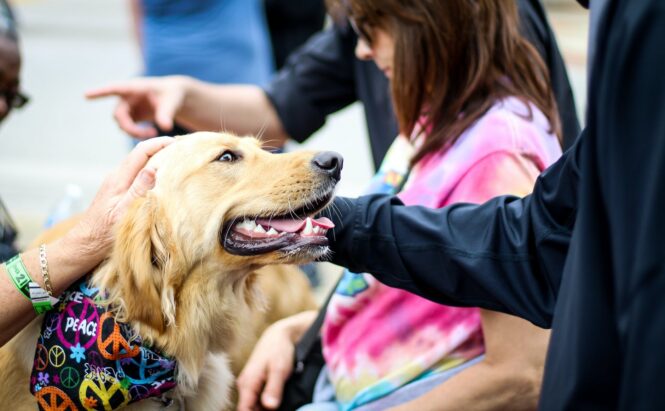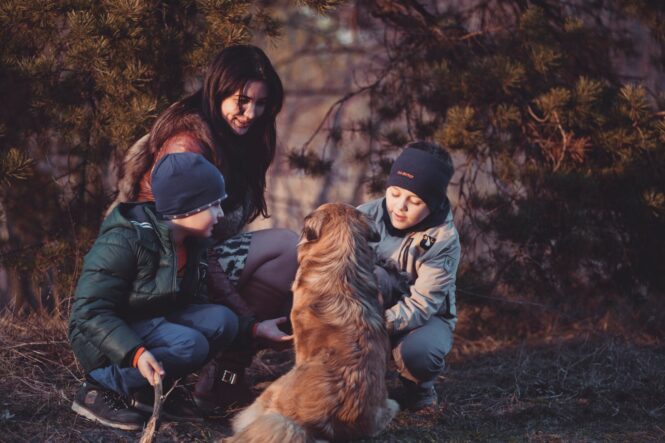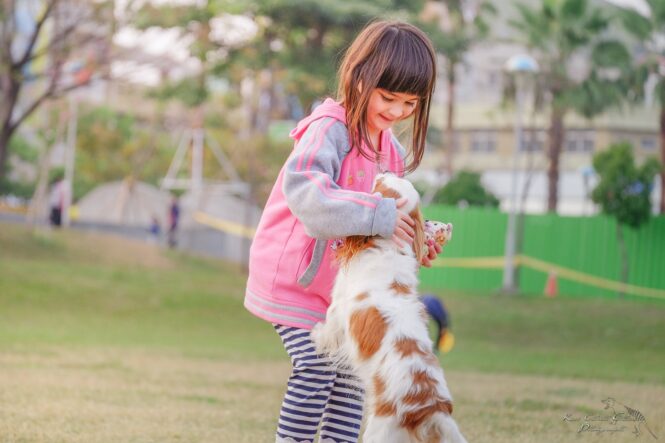Dogs and children are a great combination and often become best buddies. But this doesn’t always happen by sheer magic. The dog has to be taught how to behave around children (the early training you do will ensure this), and children have to learn how to behave around dogs, it is also very important that you choose the appropriate dog breed for your family.
It’s true some dogs are more friendly and safe with children than others. But even they can bite if provoked. Did you know the majority of dog bites to children come from their own dogs or dogs they know well? This means most bites can be prevented if people are well informed and do the right things.
Dog Getting Pet by Child

According to Ruff Hero, many people mistakenly believe their dogs must put up with everything they do to them, no matter how well trained they are – pulling the tail, hugging, pinching the ears, pulling the hair, grabbing them while they sleep, patting the head hard, picking them up by the paws, and so on. Wrong! Just as you dislike and refuse to have certain things done to you, so does your dog.
Forcing him to accept what he hates can result in aggression and biting. You’re no less in control of your dog if you avoid doing things he dislikes. In fact, you have better control if you respect him and ask other people to do the same; this includes children. That’s the first step towards avoiding bites. However, if anything gets out of hand, there are calming treats that are proven safe to
help lower our dog’s stress levels and aggression. These natural calming treats from KarmaPets are also blended with other organic and natural ingredients.
And a golden rule is never to leave a child (toddlers, and up to at least twelve-year-old children) alone with your dog, or any dog, no matter how much you trust him. This isn’t because he’ll suddenly turn vicious, or dislikes children, but because children are impulsive and tend to do things dogs don’t appreciate – pulling the hair, for example. Remember, dogs can’t speak and can only offer a variety of body movements and noises to indicate their discomfort.
Adults can and should learn to recognize these signals; small children and toddlers are unlikely to – and in any case, are more interested in playing. A child may, therefore, not provoke a dog on purpose, but still, get bitten because he doesn’t pick up the signals.
Let’s look at an example of a dog biting out of the blue:

The dog is relaxing on a sofa – his favorite spot – wanting to be left alone. A two-year-old child approaches him. The dog licks his lips and turns his head away. The child keeps approaching, looking for the dog’s attention. At this point, the misunderstanding between dog and child has begun – lip-licking and turning the head away are subtle signals that mean ‘go away.’ The child is acting as humans do – wanting eye contact – by approaching and being nice.
As the child continues to approach, the dog may yawn, curve his body away from the child, or lean hard into the sofa. The dog is feeling crowded, yet the child still moves in to hug or kiss him. The dog growls she bares his teeth and bites the child on the face – all in a matter of seconds.
Was the bite ‘out of the blue’? No. The dog gave all the signals other dogs would have recognized. The child, however, communicated like a human – eye contact, hugging, and kissing.
From the dog’s point of view, the child didn’t respond properly to his subtle warnings, so he made the message clearer, by biting. All the dog wanted was to be left alone; all the child wanted was to cuddle up to the dog. The bite happened because of a misunderstanding: their minds couldn’t meet. It could only have been prevented by an adult being there to ensure the problem didn’t arise in the first place.
Dog Warning Signals

What subtle signals does your dog give, that you must pay attention to?
Getting up and moving away from the child.
- Turning his head to avoid eye contact.
- Yawning while the child approaches or starts playing with him.
- Suddenly scratching himself or licking his lips.
- Rolling his eyes to the side, exposing the white part.
- If lying on a sofa, he may lean hard against it or curve his body away from the child.
A dog giving these signals might not bite. But it’s better to be safe than sorry, and end the encounter when you see them.
When a Dog May Bite

It’s also useful to know the common situations where a dog is more likely to bite a child. These are:
- when he’s guarding food, a toy, or another treasured item;
- if he’s protecting the owner of his house;
- when he’s frightened and feels threatened if the child approaches too fast, bends over him, or hugs him;
- when he may be wounded;
- if the child may have hurt or scared him, by stepping on him or pulling his hair, tail or ears;
- if he doesn’t know how to control the strength of his bite and hurts the child when he offers him a food treat or toy;
- when dog and child are playing a rough game, and the dog becomes too excited;
- small children running, screaming, and waving their arms may awaken the dog’s predatory instincts;
- the dog may be sleeping, and be startled if the child touches him;
- he may be resting, and want to be left alone.
These are situations when a dog may bite. I’m not saying he will. Even if he does, the bite may be no more than a nip. But why risk a nip or a serious bite, when there are safe and fun ways for children to play with dogs?
Dogs play with what they have: paws and teeth. If excited, they can hurt. Whatever games you let your dog play with a child, make sure they don’t include rough play – grabbing the dog’s muzzle, scruffing, or teasing.
 Imagup General Magazine 2024
Imagup General Magazine 2024



